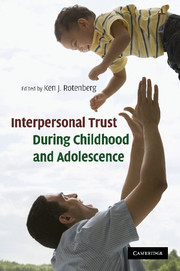Book contents
- Frontmatter
- Contents
- List of figures
- List of tables
- List of contributors
- Section I Conceptual foundations and issues
- Section II Childhood
- Section III Adolescence and early adulthood
- 10 Trust, but verify: Knowledge, disclosure, and mothers' beliefs about adolescents' trustworthiness
- 11 The role of trust in adolescent–parent relationships: To trust you is to tell you
- 12 A new scale for the assessment of adolescents' trust beliefs
- 13 A friend in need is a friend indeed: Exploring the relations among trust beliefs, prosocial tendencies, and friendships
- 14 Promoting intergroup trust among adolescents and young adults
- Index
- References
11 - The role of trust in adolescent–parent relationships: To trust you is to tell you
Published online by Cambridge University Press: 04 August 2010
- Frontmatter
- Contents
- List of figures
- List of tables
- List of contributors
- Section I Conceptual foundations and issues
- Section II Childhood
- Section III Adolescence and early adulthood
- 10 Trust, but verify: Knowledge, disclosure, and mothers' beliefs about adolescents' trustworthiness
- 11 The role of trust in adolescent–parent relationships: To trust you is to tell you
- 12 A new scale for the assessment of adolescents' trust beliefs
- 13 A friend in need is a friend indeed: Exploring the relations among trust beliefs, prosocial tendencies, and friendships
- 14 Promoting intergroup trust among adolescents and young adults
- Index
- References
Summary
Trust is a fragile plant, which may not endure inspection of its roots, even when they were, before the inspection, quite healthy
Baier, 1986, p. 260Trust has been a central construct in psychological theorizing about healthy psychosocial development, particularly from ethological and psychodynamic perspectives. For instance, in Erikson's (1950) developmental theory, developing an appropriate balance of trust versus mistrust in early childhood is one of the normative crises that must be resolved during the lifespan and is central to how later developmental crises, especially the development of identity in adolescence, is resolved. As Bernath and Feshbach (1995) have noted, for Erikson, “basic trust is … sensory, prelogical, and pervasive or fundamental” (p. 2).
Trust is also a core construct in Bowlby's and Ainsworth's attachment theory (Ainsworth, Blehar, Waters, and Wall, 1978; Bowlby, 1969/1982). Sensitive caregiving, including the caretaker's availability and responsiveness to the child's needs, is seen as facilitating the development of secure attachment relationships in infancy, leading to stable internal working models of relationships. Thus, in early childhood, trust in attachment figures' availability, dependability, and responsiveness is an integral element of attachment and relatedness (Bridges, 2003). Attachment relationships are also seen as influencing positive adjustment in childhood and beyond, and as extending to more positive peer and romantic relationships as well. In adolescence, maintaining a “goal-corrected partnership” with parents means that adolescents must maintain trust and warmth in their relationships with parents (Allen and Land, 1999).
- Type
- Chapter
- Information
- Interpersonal Trust during Childhood and Adolescence , pp. 223 - 246Publisher: Cambridge University PressPrint publication year: 2010
References
- 13
- Cited by



